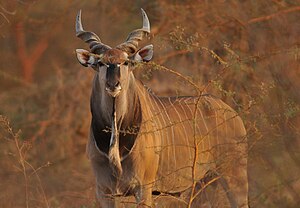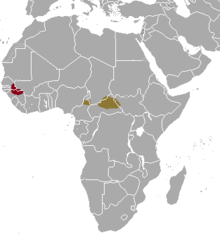Giant Eland
| Giant Eland | ||||||||||||
|---|---|---|---|---|---|---|---|---|---|---|---|---|

Western giant eland |
||||||||||||
| Systematics | ||||||||||||
|
||||||||||||
| Scientific name | ||||||||||||
| Taurotragus derbianus | ||||||||||||
| ( Gray , 1847) |
The giant eland ( Taurotragus derbianus ), also called giant elenium , is a species of antelope that lives in Africa . Despite its name, it is similar in size to the common eland , but has significantly larger horns.
features
Giant eland antelopes resemble the common eland antelopes in their physique with their massive trunk and slim limbs. They reach a head-torso length of 2.2 to 2.9 meters and a tail length of around 90 centimeters. Their shoulder height is around 1.5 to 1.8 meters and their weight is 400 to 900 kilograms, with the males being larger than the females.
Their fur is reddish-brown in color and shows some white horizontal stripes on the trunk. A short mane extends down the neck and back. They have black spots just above the hooves and on the front legs. The face is characterized by a black spot on the nose and white lips. A hairy dewlap , larger in males than females, extends in the area of the neck and chest, this is partly colored black, whereby this black coloring can also extend to the upper neck. The tassel at the end of the long tail is also black .
Both sexes have tightly twisted, straight horns that stand apart in a V-shape in the males and can be up to 1.2 meters long.
distribution and habitat
The original range of the giant eland extended over the savannah zone from Senegal to southern Sudan and Uganda . Today this area is greatly reduced and divided into two parts. The western population only occurs in Senegal and possibly in neighboring regions in Guinea and Mali . The eastern population lives in northern Cameroon , the Central African Republic and southern Sudan. Their habitat are savannahs and open forest areas .
Way of life
Giant eland live in herds of up to 60, but mostly 15 to 25 animals. In contrast to many other antelope species, the herds do not split up during the rainy season, but take longer hikes depending on the season. These animals are predominantly crepuscular or nocturnal, during the day they rest in the shade of trees. They are herbivores that feed primarily on leaves, fruits and grasses.
After a gestation period of around nine months, the female usually gives birth to a single young, which is weaned after around six months. Females reach sexual maturity at two to three and males at four to five years.
threat
As with many African antelopes, the main threats are hunting and habitat destruction. Of the western subspecies, there are only around 1000 animals left, most of which live in the Niokolo-Koba National Park in southeastern Senegal. This subspecies is listed by the IUCN as " critically endangered " , while the eastern subspecies and thus the species as a whole is classified as "not endangered" ( least concern ).
Systematics
In the past, the giant eland was listed as a subspecies of the common eland , but is now considered a separate species. Together they form the genus of the eland , which is classified within the horned bearers in the subfamily of the Bovinae . The specific epithet derbianus honors the English politician and naturalist Edward Smith Stanley , Earl of Derby.
According to the two-part distribution area, a distinction is made between two subspecies, the western giant eland ( Taurotragus derbianus derbianus ) and the eastern giant eland ( T. d. Gigas ).
literature
- Ronald M. Nowak: Walker's Mammals of the World. Johns Hopkins University Press, Baltimore 1999, ISBN 0-8018-5789-9 .
Web links
- Tragelaphus derbianus in the endangered Red List species the IUCN 2009. Posted by: IUCN SSC Antelope Specialist Group, 2008. Accessed November 7 in 2009.
- Giant Eland on ultimateungulate.com (English)


